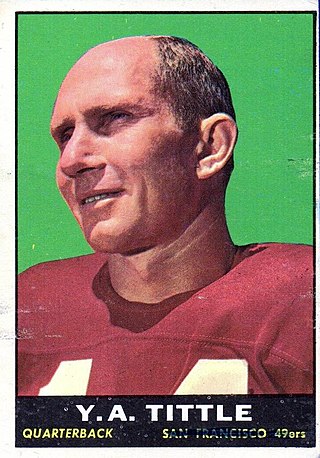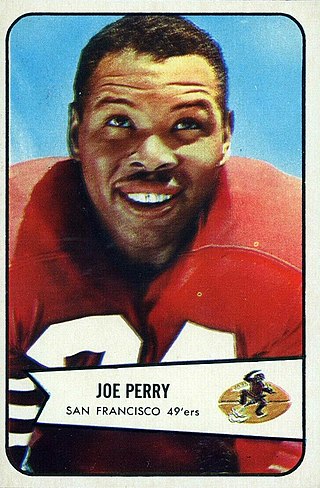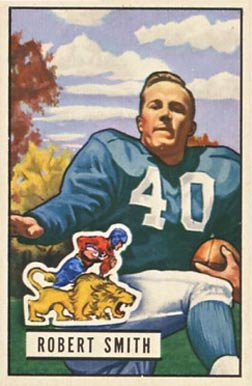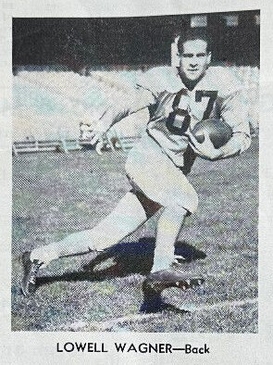
The All-America Football Conference (AAFC) was a major professional American football league that challenged the established National Football League (NFL) from 1946 to 1949. One of the NFL's most formidable challengers, the AAFC attracted many of the nation's best players, and introduced many lasting innovations to the game. However, the AAFC was ultimately unable to sustain itself in competition with the NFL. After it folded, three of its teams were admitted to the NFL: the San Francisco 49ers, the Cleveland Browns and the original Baltimore Colts.

Yelberton Abraham Tittle Jr. was an American professional football player who was a quarterback. He played in the National Football League (NFL) for the San Francisco 49ers, New York Giants, and Baltimore Colts, after spending two seasons with the Colts in the All-America Football Conference (AAFC). Known for his competitiveness, leadership, and striking profile, Tittle was the centerpiece of several prolific offenses throughout his 17-year professional career from 1948 to 1964.

Fletcher Joseph Perry was an American football fullback who played in the All-America Football Conference (AAFC) and National Football League (NFL). He played for the San Francisco 49ers from 1948 to 1960, the Baltimore Colts from 1961 to 1962, and returned to the 49ers in 1963 for his final year in football. He was exceptionally fast, a trait uncommon for a fullback and one which earned him the nickname, "the Jet". The first African-American to be named the NFL Most Valuable Player (MVP), he became one of American football's first black stars.

Frank Cullen Albert was an American professional football player and coach. He played as a quarterback and punter with the San Francisco 49ers in the All-America Football Conference (AAFC) and later in National Football League (NFL). He played college football for the Stanford Indians, where he led the 1940 football team to an undefeated season and the 1941 Rose Bowl.
The 1947 Cleveland Browns season was the team's second in the All-America Football Conference (AAFC). Led by head coach Paul Brown, Cleveland finished with a 12–1–1 record, winning the Western division and the AAFC championship for the second straight year. As in 1946, quarterback Otto Graham led an offensive attack that featured fullback Marion Motley, ends Dante Lavelli, and Mac Speedie.
The 1948 Cleveland Browns season was the team's third in the All-America Football Conference (AAFC). After winning the AAFC crown in 1946 and 1947, the league's first two years of existence, the Browns repeated as champions in 1948 and had a perfect season, winning all of their games.
The 1949 Cleveland Browns season was the team's fourth and final season in the All-America Football Conference (AAFC). The Browns finished the regular season with a 9–1–2 win–loss–tie record and beat the San Francisco 49ers to win their fourth straight league championship. In the season's sixth game on October 9, the 49ers stopped the Browns' professional football record unbeaten streak at 29 games. It began two years earlier on October 19, 1947, and included two league championship games and two ties.

Warren Emmett Lahr was an American professional football player who was a defensive back who played for the Cleveland Browns for 11 seasons, mainly in the 1950s. When he retired, he had the most career interceptions in Browns team history with 44.

Leonard Charles Eshmont was an American professional football halfback and safety for the New York Giants of the National Football League (NFL) and the San Francisco 49ers, then in the All-America Football Conference (AAFC).

James Robert Smith was an American football defensive back, halfback and punter. He played in the National Football League (NFL) for the Detroit Lions from 1949 to 1954. He played for NFL championship teams in Detroit in 1952 and 1953 and was selected as a first-team All Pro after the 1952 season. He also played in the All-America Football Conference (AAFC) for the Buffalo Bills (1948), Brooklyn Dodgers (1948), and Chicago Hornets (1949). Smith played college football for the Tulsa Golden Hurricane, the Iowa Pre-Flight Seahawks (1944), and the Iowa Hawkeyes (1946–1947).

Lowell Wagner was a professional American football cornerback in the All-America Football Conference (AAFC) and the National Football League (NFL). He played eleven seasons for the AAFC's New York Yankees (1946–1948) and AAFC and NFL's San Francisco 49ers (1949–1955).

Guadalupe Joseph Arenas, also known as "Lupe Joe" Arenas and "Little Joe" Arenas, was an American football player. He was a halfback and defensive back for the San Francisco 49ers from 1951 to 1957. He was best known as a kickoff and punt returner. His 4,572 career kick and punt return yards was the best in NFL history at the time of his retirement, and his career average of 27.3 yards per kick return remains ninth best in NFL history. Arenas was, along with Tom Fears and Eddie Saenz, among the first Mexican-American players to achieve significant success in the sport of American football.

Homer Brown Hobbs was an American football player and coach. He played professionally as a guard for the San Francisco 49ers of the All-America Football Conference (AAFC) and National Football League (NFL).

Alfred Ernest Bauman was an American football player.

The 1946 Michigan Wolverines football team represented the University of Michigan in the 1946 Big Nine Conference football season. In their ninth year under head coach was Fritz Crisler, the Wolverines compiled a 6–2–1 record, outscored opponents 233 to 73, and finished the season in second place in the Big Nine Conference and ranked No. 6 in the final 1946 AP poll. The team's two losses came against an undefeated Army team that was ranked No. 2 in the final AP poll and against an Illinois team that won the Big Nine championship and was ranked No. 5 in the final AP poll. Michigan won its last four games by a combined score of 162 to 19, starting a 25-game winning streak that continued for nearly three years until October 8, 1949. In the final game of the 1946 season, Michigan defeated Ohio State, 58–6, the Buckeyes' worst defeat since joining the conference in 1913.

Kenneth Thomas Casanega was an American professional football player who was a quarterback for two seasons with the San Francisco 49ers of the All-America Football Conference (AAFC). He played college football at Santa Clara University, having previously attended Castlemont High School in Oakland, California. He later was a school administrator.
Edward T. Balatti, also known as Attilio Balatti was an American football cornerback and tight end who played three seasons for the San Francisco 49ers, also spending time with the Buffalo Bills and New York Yankees. He also played for the San Francisco Packers and the San Francisco Clippers of the Pacific Coast Professional Football League.
Donald Arthur Garlin was an American football halfback and defensive back.

Paul James Crowe was an American football player who played at the halfback and defensive back positions. He played college football for Saint Mary's military football for the 1944 Saint Mary's Pre-Flight Air Devils football team, and professional football for the San Francisco 49ers, Los Angeles Dons, and New York Yanks.

Robert Melvin "Bob" Mike was an American and Canadian football player who played at the tackle position on both offense and defense. He played college football for Florida A&M and UCLA and professional football for the San Francisco 49ers of the National Football League and the Calgary Stampeders of the Canadian Football League (CFL).
















